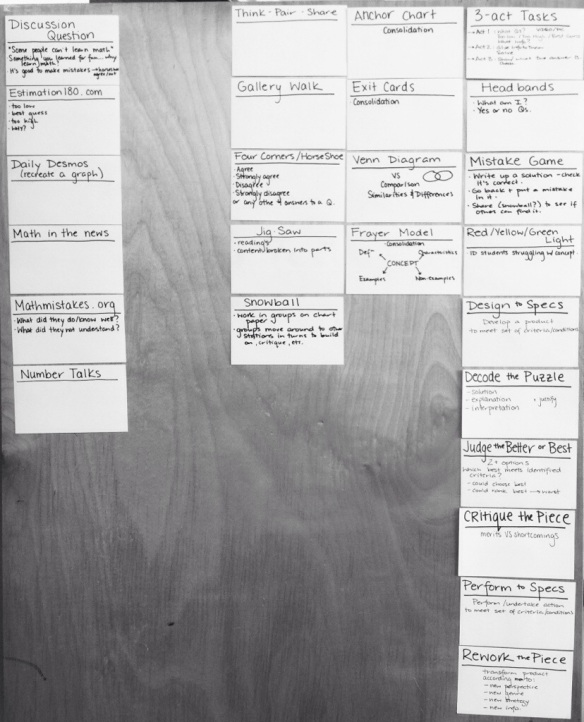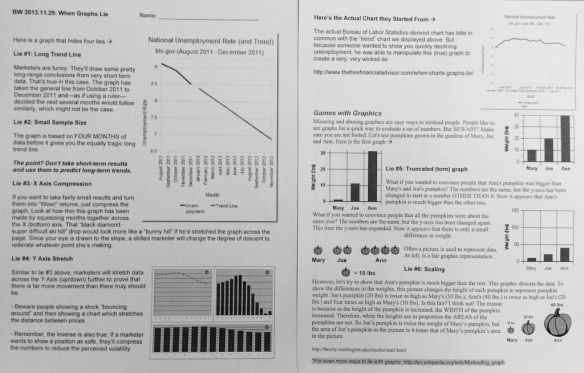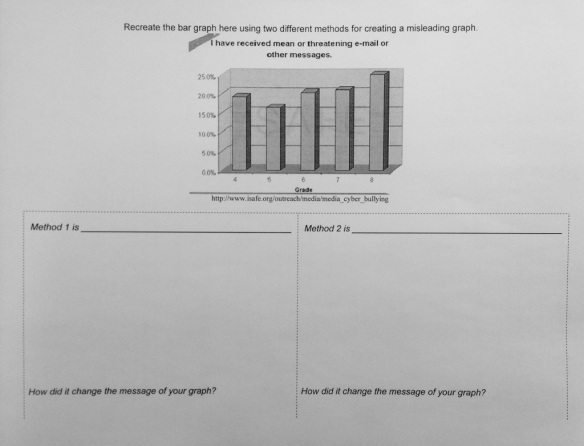My student-teacher is finishing up her month of practicum in my classroom. On the one hand, having a student-teacher adds to my workload in that I spend a lot of time coaching them through their lesson planning, observing their teaching, and then giving them feedback. On the other hand, while I’m in the classroom quietly observing I can sometimes work on other little projects that I don’t usually have the time for.
This time around, my project was to create an “idea board” for activity types to be implemented in my classroom. It’s nothing fancy (I am a math teacher after all, not art!). Here’s a look at the idea board I’ve created on the inside of a cupboard door in my classroom:
On the left is a column of ideas for my bellwork activities. On the right are 3 columns of main lesson/activity types. I have somewhat organized those into; sharing of ideas or products (left), consolidation of learning/concepts (middle), and learning, investigating, exploring & working (right).
My hope is that I’ll refer to this in order to avoid the old chalkNtalk type lessons.
For example, I was creating a lesson last night about the ways in which graphs can be misleading for MAP4C (gr.12 college math). After an hour of work looking for good examples and explanations accessible to my grade 12 college students, I came up with a 2 page information handout that looks like this:
The plan was to have them read the information and then summarize in their own words. But as I drove home I thought “what a bad activity”; read & summarize. They won’t understand or remember any of the material. As the saying goes, “Tell me and I’ll forget. Show me and I’ll remember. Involve me and I’ll understand”. So with that thought in mind, and wanting to engage my students in activities that require them to think critically, I thought about the activity types on my idea board.
I chose to try a “Rework the Piece” activity. “Rework the Piece” is something I had done in the past, but was formally explained to me as a prompt for critical thinking by Garfield Gini-Newman. The idea is to have students transform a product in light of new information or a new perspective. So in addition to the 2 page handout with the information I will give my students, I created a task asking them to take an existing bar graph & transform it using any 2 of the methods outlined in the information document in order to have the graph deliver a different or misleading message. It looks like this:
Hopefully by requiring them to use the information in order to perform a task, they will better understand the concepts and how to apply them. I am always open to suggestions of ways to make my activities even better – hit me up in the comment section below with your ideas!
How could you use an idea board to help inspire your lesson planning?
Update!
I have since found this thread of blog posts by MathCurmodgeon showing graphs that distort the data that I plan to use for this topic of MAP4C the next time I teach the course:
http://matharguments180.blogspot.ca/search/label/FixThatGraph!
– Laura Wheeler (Teacher @ Ridgemont High School, OCDSB; Ottawa, ON)



